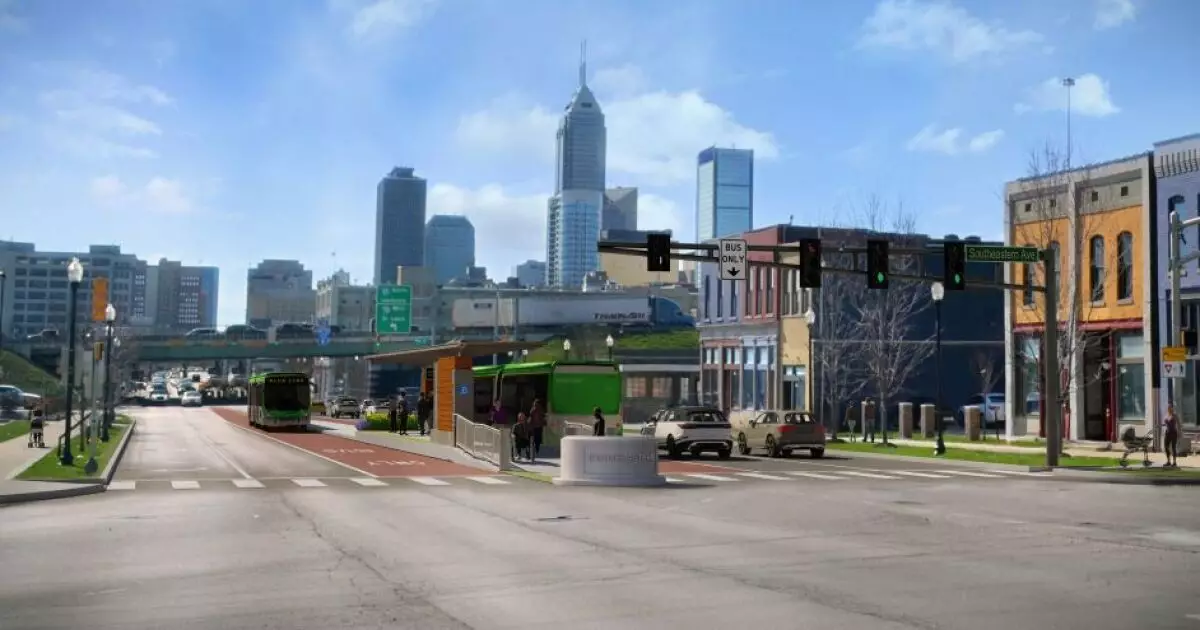Urban transit systems are the arteries of city life, transporting millions while supporting economic vitality. The recent announcement concerning a $125 million bond sale to fund the Blue Line Bus Rapid Transit (BRT) project in Indianapolis encapsulates the essential role of innovative public transport in urban development. This project doesn’t merely aim to enhance existing services; it challenges the norms of transportation infrastructure, setting a precedent for how cities may adapt to growing populations and changing commuting patterns.
This proposed 24-mile route stretching from the Indianapolis International Airport to downtown and extending to the eastern reaches of Marion County is more than just a new bus line. It represents a critical pivot toward a transportation model that prioritizes efficiency and accessibility. While there may be concerns about rising municipal yields and fluctuating market conditions, the decision to postpone pricing is indicative of prudent fiscal management—something sorely needed in contemporary public finance debates.
Understanding the Financial Mechanics
The structure of the Series 2025A local income tax revenue bonds reveals a comprehensive approach toward funding urban transport. With an AA-minus rating from S&P Global Ratings, these bonds offer a reliable basis for investment, underscoring the financial discipline behind IndyGo’s strategic direction. The bond’s framework includes repayment sourced from a dedicated local income tax, highlighting a sustainable revenue model that could weather economic storms.
However, a careful reading of the bond structures also exposes inherent risks. The debt service reserve fund, while a safeguard during financial hardships, does not constitute a reserve under Indiana law. This unique aspect calls for scrutiny, especially when considering potential market fluctuations and financing requirements during a period marked by economic uncertainty.
Acknowledging these risks doesn’t detract from the benefits of the project; rather, it invites a dialogue about financial prudence and systemic resilience in public-sponsored initiatives. Left unchecked, reliance on uniform revenue sources could deepen vulnerabilities during market disruptions, potentially threatening the vital service IndyGo provides.
The Demand for Modern Transit Solutions
As cities grapple with issues stemming from urbanization and unpredictable market trends, the emphasis on Bus Rapid Transit systems is both timely and necessary. Traditional transit services often fall short in flexibility and speed, bearing the burden of antiquated practices in managing urban mobility. The Blue Line’s design promises to alleviate issues faced by commuters—efficient routes, reduced travel times, and increased accessibility, and that is something to be celebrated.
The construction of 36 new bus stations along this line is a significant investment in the fabric of urban transportation. It encourages ridership and community connection, actively engaging residents in urban spaces. In a world where remote working is replete with new considerations, such projects provide tangible benefits and reinforce transit as an integral part of the urban infrastructure. Transit systems should not simply move people; they need to connect them to opportunities, services, and one another.
The Role of Community Engagement
While economic metrics are vital in evaluating such initiatives, they should not overshadow the importance of community engagement. The decisions taken by IndyGo, such as postponing bond pricing to await market corrections, demonstrate accountability to taxpayers and constituents. This participatory approach fosters trust and highlights the need for transparency in public financing.
Public discussions surrounding the BRT project should extend beyond financial feasibility. Community forums, outreach programs, and strategic communications must pave the way for a broader understanding of how these changes affect the daily lives of Indianapolis’ residents. Fostering a dialogue will generate invaluable feedback that can further inform the project’s execution and sustainability, empowering residents and enhancing their investment in their public transit system.
Looking Towards the Future
Ultimately, the Blue Line project offers Indianapolis a glimpse into a promising future for urban transportation. While substantial challenges remain—especially in terms of balancing fiscal prudence with transformative goals—the proactive measures being adopted signify an important step forward.
Conversely, as we celebrate this momentary triumph, we must not lose sight of the need for continuous evaluation and adaptation. With the structure of the local economy ever-changing and a globalized world interconnected through technology, the measures you take today will reverberate through generations. As a city, Indianapolis must seize this opportunity to reshape its transit landscape, ensuring that it remains resilient, forward-thinking, and ready to meet the demands of tomorrow’s commuters.
As the Blue Line project moves closer to fruition, it will be an essential case study on how urban entities navigate the complexities of financing, community needs, and the overarching ambition of modern transit systems in evolving economies.

